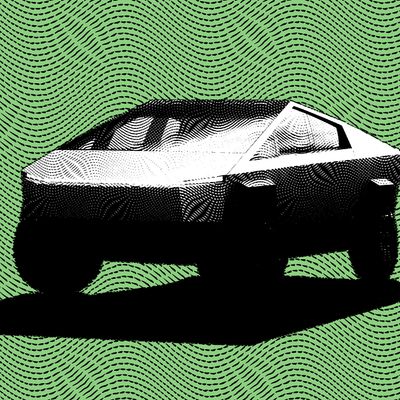
Photo-Illustration: Intelligencer; Photo: Tesla
In the spirit of disclosure, I’m going to admit that I think driving a Tesla Cybertruck would absolutely rule. It’s a fast, weird fantasy car — the kind of concept that usually doesn’t make its way off the Javits Center showroom floor and onto the road. Yes, it looks like something out of a 1980s Ridley Scott movie and it’s made by Elon Musk, but at least you can tell it apart from every other passenger vehicle. Part of what makes it fun is how ostentatious the thing is. It’s the opposite of the anonymous wealth signifiers preferred by the Succession class and the tech titans who control our lives. (Parking it, though, would be a nightmare.) On Thursday, Tesla will start to deliver Cybertrucks after four years of delays and production snafus. As much as I want to own or even just drive one, it’s difficult to imagine a worse environment for introducing a new electric vehicle that is the result of four years and billions of dollars of development. No matter how many people secretly covet a Cybertruck, it faces a very rocky road. As anyone who has seen a certain viral video knows, Musk and Tesla investors may find themselves stranded by the Cybertruck.
Electric vehicles are contending with a lot of problems in the U.S. The frothy projections from last year about their growth seem to have involved a lot of wishful thinking, and this year has shown — at least for the moment — that there is a ceiling on how many people actually want to buy them. It is, at least in part, a case of expectations having gone too far, too fast. EV sales are expected to top 1 million this year, up from 918,000 last year, according to an October Cox Automotive report. Still, that amount represents a huge disappointment for the industry as the number of electric vehicles actually produced more than quadrupled from last year. This has prompted car companies to prepare for further slowdowns. A car plant jointly run by GM and Honda was scrapped last month, just one year after the two auto giants announced the partnership. Ford cut one-third of its shifts at a plant building electric F-150s, which would affect about 700 jobs and slow down production.
Maybe the disappointing levels of buyer interest have something to do with the fact that lithium-ion batteries are susceptible to exploding. Or people are just holding on to the cars they already have for longer. Or there’s nowhere to charge them. But the biggest problem is price: Electric vehicles start at around $27,000, and that’s for a car that goes about 250 miles on a single charge. But most electric vehicles cost around twice as much, with top-of-the-line luxury versions reaching around $100,000. These are lifestyle vehicles for a small segment of the population, the wealthy who want to seem as though they’re not like the other one-percenters in that they actually care about the environment. Have you seen a Rivian? It’s practically an REI store on wheels, complete with the insane pricing. But even with six-figure price tags, Rivian still can’t figure out how to make money. Factor in auto loans now having rates upwards of 5.5 percent. Even Musk has been publicly fretting about how much interest rates are eating into his sales.
The other problem for Tesla is that, for the first time, it is delivering a new product when it doesn’t have a majority of the market to itself. Tesla first announced the truck in 2019, when it got more than 250,000 preorders at $100 each, in the first few days. But because of problems with the production and design — which created “high head-toss acceleration” and “structural shake,” according to leaked internal files — Tesla has been pushing back deliveries ever since. The first sales are rumored to be the top-of-the-line tri-motor models, which are expected to cost around $100,000, with the cheaper models coming sometime in 2024 or after. And Tesla recently tried to make anyone buying a Cybertruck commit to being all-in on the car, at least for the first year. The company inserted — and then quietly removed — a clause in the Cybertruck sales agreement which said buyers would face a $50,000 penalty if caught selling it before then, and could be banned for life from buying any other Teslas.
And then there’s the actual production. Earlier this month, late prototypes seen in the wild looked like a puzzle that wasn’t put together correctly: There were gaps between the panels that appeared far larger than the “sub 10 micron” accuracy level decreed by Musk. The blind spot was wide, and rear visibility was poor. In isolation, these might be forgivable, especially considering this was still a prototype. But taken together, the car seemed unfinished. Even putting a black wrapping on it didn’t appear to win many converts.
And look, maybe winning new customers with the Cybertruck isn’t the point. This is a vehicle Joe Rogan said is “the coolest car I’ve ever seen in my life.” (Rogan also shot one with an arrow.) Making expensive niche products for people with too much money tends to be a really great business, and Musk has made himself the richest person in the world by being exceptionally good at that. But there are limits to any market, and in order for Tesla to really see success, it will have to not only convert new buyers but upsell to people who already own Teslas. (And remember, most of Musk’s other vehicles look like sleek versions of things you already see on the road, or at least at high-end dealerships.) The last time it brought a new car to the public, in March 2019, Tesla had almost 80 percent of the market to itself. According to Cox’s most recent report, the company’s share of the electric-vehicle market has fallen to 50 percent. That’s still an extremely large portion of EV consumers, but it is falling. For Musk, that’s going to make it all the more difficult to sell this thing to anybody but the most die-hard fan.
This post has been updated to note that Tesla quietly backtracked on its threat to impose a penalty fee on Cybertruck resellers.






